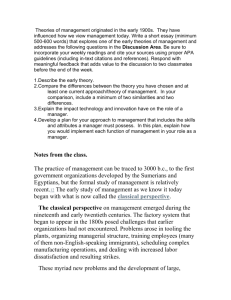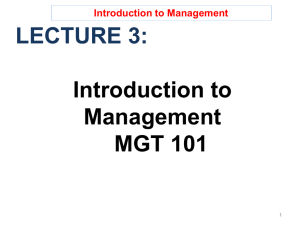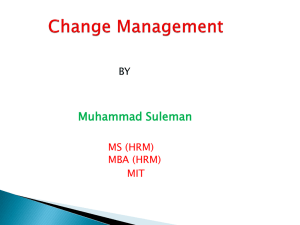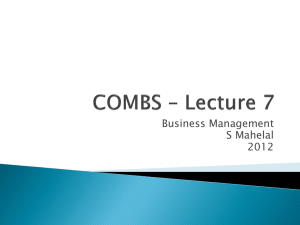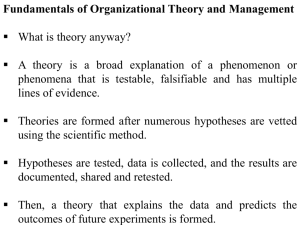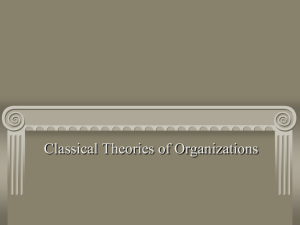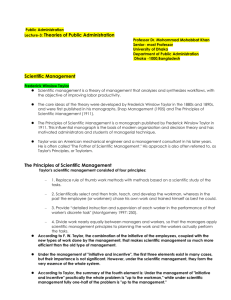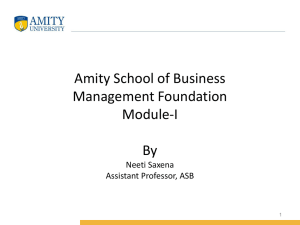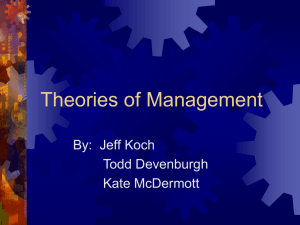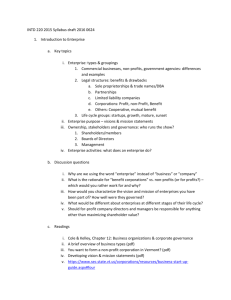Scientific Management Theory
advertisement
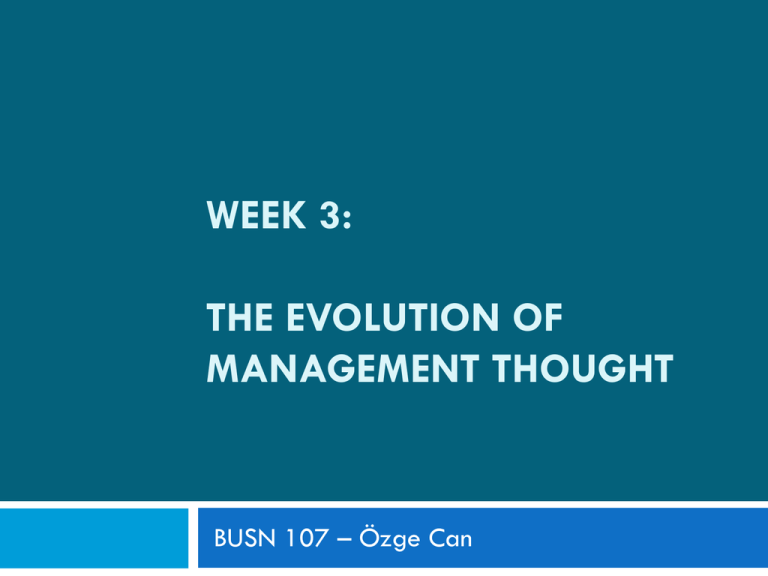
WEEK 3: THE EVOLUTION OF MANAGEMENT THOUGHT BUSN 107 – Özge Can The Evolution of Management Thought How management thought have evolved over time The economic, political and cultural forces affected the development of management theories How managers and organizations have changed their behavior The Evolution of Management Thought Classical management theories (around the turn of the 20th century) Behavioral management theories (before and after World War II) Management science theory (from WWII onward) Management environment theories (from the middle to the late 20th century) The Evolution of Management Thought Organizational Environment Theory Management Science Theory Behavioral Management Theory Administrative Management Theory Scientific Management Theory 1890 1900 1910 1920 1930 1940 1950 1960 1970 1980 1990 2000 Evolution of modern management began in the late 19th century, after industrial revolution Scientific Management Theory Industrial revolution through Europe and America Many major economic, technical and cultural changes Introduction of steam power Sophisticated machinery and equipment Change from small-scale crafts production to largescale mechanized manufacturing Small-scale Crafts Production Large-scale Mechanized Manufacturing Scientific Management Theory Scientific Management The systematic study of relationships between people and tasks for the purpose of redesigning the work process to increase efficiency Developed Job by Frederick W. Taylor (1856-1915) Specialization: The process by which division of labor occurs as different workers specialize in different tasks over time Job Specialization Better Organizational performance Division of Labor Increased Efficiency Taylor’s Principles 1. Study the way workers perform their tasks, gather all informational job knowledge that workers possess, and experiment with ways of improving how tasks are performed Taylor’s Principles 2. Codify the new methods of performing tasks into written rules and standard operating procedures. 3. Carefully select workers who possess skills and abilities that match the needs of the task, and train them to perform the task according to the established rules and procedures. Taylor’s Principles 4. Establish a fair or acceptable level of performance for a task, and then develop a pay system that provides a reward for performance above the acceptable level. More harm than good... As workers’ performance increased, managers required them to do more work for the same pay Increases in performance meant fewer jobs and greater threat of layoffs Monotonous, repetitive and boring work Increasing dissatisfaction of workers Deterioration in workers’ well-being Modern Times, 1936 film by Charlie Chaplin Ford Motor Company Achieving the right mix of worker-task specialization as Taylor suggests Linking people and tasks by the speed of the production line Videos on Taylorism: http://www.youtube.com/watch?v=8PdmNbqtDdI&f eature=related http://www.youtube.com/watch?v=fF_YvY7jfiE Administrative Management Theories Administrative Management The study of how to create an organizational structure that leads to high efficiency and effectiveness Theory of Bureaucracy Fayol’s Principles of Management Theory of Bureaucracy Max Weber (1864-1920) Developed the principles of bureaucracy-a formal system of organization and administration designed to ensure efficiency and effectiveness. Bureaucracy: A formal system of organization and administration designed to ensure efficiency and effectiveness System of written rules and SOPs that specify how employees should behave Clearly specified system of task and role relationships A bureaucracy should have Selection and evaluation system that rewards employees fairly and equitably Clearly specified hierarchy of authority Weber’s Principles of Bureaucracy: A Manager’s formal authority derives from the position he or she holds in the organization People should occupy positions because of their performance, not because of their social standing or personal contacts. Weber’s Principles of Bureaucracy: The extent of each position’s formal authority and task responsibilities and its relationship to other positions in an organization, should be clearly specified. Authority can be exercised effectively in an organization when positions are arranged hierarchically, so employees know whom to report to and who reports to them. Weber’s Principles of Bureaucracy: Managers must create a well-defined system of rules, standard operating procedures and norms so that they can effectively control behavior within an organization. Fayol’s Principles of Management Henri Fayol (1841-1925) He identified 14 principles he believed essential to increase the efficiency of the management processs. Behavioral Management Theories The Work of Mary Parker Follett The Hawthorn Studies and Human Relations Theory X and Y Behavioral Management: The study of how managers should behave to motivate employees and encourage them to perform at high levels and be committed to the achievement of organizational goals. Mary Parker Follett Mary Parker Follett advocated for a human relations emphasis Her work contrasted with the "scientific management" of Frederick W. Taylor Stressed the interactions of management and workers Advocated involvement of workers in job analysis and work development process Differentdepartments should communicate with each other directly (Cross-functioning) The Hawthorne Studies and Human Relations Hawthorn Effect: The finding that a manager’s behavior or leadership approach can affect worker’s level of performance. Human Relations Movement: Advocates of the idea that supervisors receive behavioral training to manage subordinates in ways that elicit their cooperation and increase their productivity. The Hawthorne Studies and Human Relations Informal Organization: The system of behavioral rules and norms that emerge in a group. Organizational Behavior (OB): The study of the factors that have an impact on how individuals and groups respond to and act in organizations. Theory X and Theory Y Douglas McGregor proposed that two sets of assumptions about how work attitudes and behaviors not only dominate the way managers think but also affect how they behave in organizations. He named these two assumptions Theory X and Theory Y. Theory X and Theory Y Theory X: A set of negative assumptions about workers A manager’s task is to supervise workers closely and control their behavior Theory Y: A set of positive assumptioms about workers Encouraging commitment, provide opportunities to exercise initiative and selfdirection Management Science Theory An approach to management that uses rigorous quantitative techniques to help managers make maximum use of organizational resources. Quantitative Techniques Operations Management Total Quality Management Management Information Systems Organizational Environment Theory The set of forces and conditions that operate beyond an organization’s boundaries but affect a managers ability to acquire and utilize resources. The Open-System View Contingency Theory Organizational Environment Theory Open-System: A system that takes in resources from its external environment and convert them into goods and services that are then sent back to the environment for purchase Closed-systems: Are not influenced by and do not interact with their environment (all system input and output is internal) The Organization as an Open-System: Organizational Environment Theory Contingency Theory: The idea that the organizational structures and control systems depend on characteristics of the external environment in which the organization operates. No one universally applicable set of management principles by which to manage organizations. Organizations face different situations and require different ways of managing. Next Week: Read: Textbook, Chapter 3 – The Manager as a Person Remember: Deadline for Assignment-1
